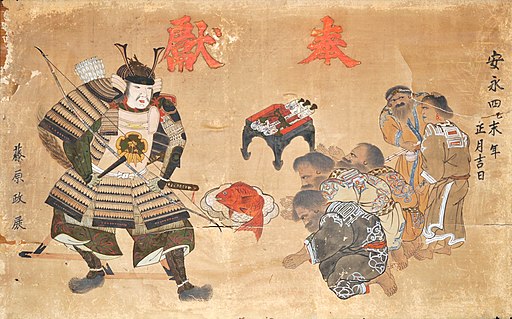1 アイヌ民族の昔の歴史 Early Ainu History
The vocabulary and kanji exercises are based on words and characters that appear in the reading and that will be useful in expressing ideas about history, culture, trade and a fisher-hunter-gatherer society. The reading selection is appropriate for upper beginner level.
読む前に、単語を覚えましょう。
漢字の練習をしましょう。
Choose the option for the kanji that completes the word. (問題は六つあります。)
本文を読みましょう。
Click on the words in red to see the reading and meaning.
今の北海道には、2万5千年前から人が住んでいたと言われている。そのころは、海水のレベルが今より低かったから陸がつながっていて、今の中国やロシアのサハリンや韓国から、日本に人が入ってきた。

そして、今のアイヌ文化とされるものは、八百年ぐらい前にあらわれた。アイヌの民族は、北海道だけじゃなくて、本州の東北地方とサハリンと北海道の北東にある小さい島にも住んでいた。アイヌの人たちは自分たちが住む土地を「アイヌモシリ」と言った。「アイヌ」は「人間」、「モ」は「しずか」、「シリ」は「大地」を意味する。[1]

13世紀ごろから、南の方に住んでいた和人(今の日本人)とアイヌの人たちは交流や交易(食べ物や他の物を交換すること)をし始めた。そのころの和人は、北海道を「えぞ」と言った。江戸時代 (1603 – 1868)に入ってからは、物の交換をする人がもっと多くなった。アイヌの人たちは魚や昆布や毛皮、和人はお米やお酒やお皿などを交換したが、交換の条件は不公平で、和人の方がお金をもうけるようになっていた。それで、アイヌの人たちは不満を感じて、時々あらそいが起こった。

1750年ごろからは、和人はニシンという魚を交換しに、えぞに行った。ニシンの釣りはたいへんな仕事だったが、和人がほしがっていたから、アイヌの人たちは釣りをしなくてはいけなかった。そして、その仕事でたくさんのアイヌの人が苦労した。同時に、和人がアイヌモシリになかった新しい病気を持ってきてしまった。その病気で死んでしまった人も多かった。
わかりましたか。チェックしましょう。(練習問題は六つあります。)
文法の説明
Sentences Modifying Nouns (in English, Relative Clauses)
Sentences can, like adjectives, modify nouns to give more information about that noun. For example, in the following sentence, ‘where they live’ modifies and gives more information about the noun ‘land.’ The Ainu called the land where they live “Ainu Moshir.” The equivalent sentence in Japanese is アイヌは自分が住む土地を「アイヌモシリ」と言った。In English, we require a relative pronoun (in this sentence, ‘where’) to introduce the modifying sentence ‘they lived.’ In Japanese, however, it’s much easier to create these modifiers because you just need to put the sentence in the plain form and place it in front of the noun – 住む土地. There’s no need for the relative pronouns like “who”, “which”, “where”, etc. that are required in English. See if you can spot the modifying sentences in the following exercise.
文法の練習
文法の説明
〜てしまう is a verb construction used to show that something regrettable, unintentional or unfortunate happens or happened. The main verb is conjugated into the 〜て form and attached to a form of the verb しまう (which literally means to completely finish doing something).
文法の練習

考えましょう かんがえましょう Reflection
What do you think the painting above indicates about how the Wajin of the time viewed the Ainu people? Can you think of any similar paintings from your own cultural tradition that record encounters with Indigenous Peoples and early settlers?
Media Attributions
Vase by The Trustees of the British Museum is licensed under CC BY-NC-SA 4.0.
“Kiska Kelp” by Buzz Hoffman is licensed under CC BY-NC-SA 2.0.
Samurai and Ainu Fuzoku Ema by painter unknown. Public domain.
- Kayano Shigeru, Ainu to kamigami no monogatari: Robata de kiita uwepekere (Tokyo: Yamakei Library, 2020), 21. ↵
たんご word, vocabulary
おぼえる to remember, commit to memory
かんじ Chinese (Japanese) characters
れんしゅう to practice, exercise
もんだい problem
すむ to live
ひくい (ひくかった) low
りく land
ちゅうごく China
かんこく South Korea
ぶんか culture
to appear, emerge
みんぞく race, people
ほんしゅう Honshū- the main island of Japan
とうほくちほう Tōhoku region
ほくとう Northeast
しま island
じぶん self, oneself
とち land, property
にんげん human
だいち vast land, earth
いみ meaning
せいき century
わじん non-Ainu Japanese people
こうりゅう exchange
こうえき trade
たべもの food
こうかん exchange
こんぶ kelp
けがわ fur
おこめ rice
おさけ alcohol
おさら plates, dishes
じょうけん terms, conditions
ふこうへい unfair
to make a profit
ふまん dissatisfaction
ときどき time to time
あらそい dispute, fight (verb - あらそう)
herring
つり fishing
しごと work
くろう trouble, hardship
どうじ at the same time
びょうき disease, sickness
ぶんぽう grammar
せつめい explanation (verb - せつめいする)

